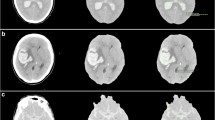Abstract
Purpose
Between 15 and 30 % of patients with subarachnoid hemorrhage (SAH) have no bleeding source and usually have a benign clinical course and outcome. The objectives of this study were to classify the pattern of blood distribution on initial computed tomography (CT) and to correlate it with clinical outcome in aneurysmal (ASAH) and SAH of unknown origin (SAHuO).
Methods
We reviewed 112 CTs of SAHuO and 104 CTs of ASAH patients. Blood distribution was classified according to a new grading system (type 0–4) and correlated to Hunt and Hess (H&H) grade and modified Rankin scores (MRS) at short- and long-term follow-up.
Results
Fifty percent of 112 SAHuO patients were classified as type 0 (no visible blood on CT) or 1 (blood restricted to prepontine cisterns). Most ASAH patients presented with bleeding into the lateral Sylvian fissure (66%; type 3) or with intracerebral hemorrhage (27%; type 4) whereas types 0 and 1 were not observed. SAHuO patients were in better clinical condition on admission than ASAH patients (p < 0.0001). H&H grades of SAHuO patients correlated with the amount of subarachnoid blood according to the new classification (p = 0.004). Short-term outcome was obtained from 100% and long-term outcome from 95% patients (follow-up 29 ± 31 months). Short- and long-term MRS correlated with blood distribution in SAHuO patients (p = 0.012) and was significantly better than in ASAH patients (p < 0.0001). No correlation was observed between blood distribution, H&H grade, and short- and long-term outcome in aneurysmal patients.
Conclusions
In SAH of unknown origin, a new classification allows to predict outcome based on the extent of blood on CT.





Similar content being viewed by others

References
Brismar J, Sundbarg G (1985) Subarachnoid hemorrhage of unknown origin: prognosis and prognostic factors. J Neurosurg 63:349–354
Canhao P, Ferro JM, Pinto AN, Melo TP, Campos JG (1995) Perimesencephalic and nonperimesencephalic subarachnoid haemorrhages with negative angiograms. Acta Neurochir (Wien) 132:14–19
Duong H, Melancon D, Tampieri D, Ethier R (1996) The negative angiogram in subarachnoid haemorrhage. Neuroradiology 38:15–19
Ferbert A, Hubo I, Biniek R (1992) Non-traumatic subarachnoid hemorrhage with normal angiogram. Long-term follow-up and CT predictors of complications. J Neurol Sci 107:14–18
Hunt WE, Hess RM (1968) Surgical risk as related to time of intervention in the repair of intracranial aneurysms. J Neurosurg 28:14–20
Ildan F, Tuna M, Erman T, Gocer AI, Cetinalp E (2002) Prognosis and prognostic factors in nonaneurysmal perimesencephalic hemorrhage: a follow-up study in 29 patients. Surg Neurol 57:160–165 discussion 165-166
Ildan F, Tuna M, Erman T, Gocer AI, Cetinalp E, Burgut R (2002) Prognosis and prognostic factors for unexplained subarachnoid hemorrhage: review of 84 cases. Neurosurgery 50:1015–1024 discussion 1024-1015
Kaim A, Mader I, Kirsch E, Radu EW, Steinbrich W (1995) Perimesencephalic subarachnoid hemorrhage: clinical and computer tomography aspects. Rofo 162:274–281
Rinkel GJ, Wijdicks EF, Vermeulen M, Hageman LM, Tans JT, van Gijn J (1990) Outcome in perimesencephalic (nonaneurysmal) subarachnoid hemorrhage: a follow-up study in 37 patients. Neurology 40:1130–1132
Ronkainen A, Hernesniemi J (1992) Subarachnoid haemorrhage of unknown aetiology. Acta Neurochir (Wien) 119:29–34
Topcuoglu MA, Ogilvy CS, Carter BS, Buonanno FS, Koroshetz WJ, Singhal AB (2003) Subarachnoid hemorrhage without evident cause on initial angiography studies: diagnostic yield of subsequent angiography and other neuroimaging tests. J Neurosurg 98:1235–1240
Van Calenbergh F, Plets C, Goffin J, Velghe L (1993) Nonaneurysmal subarachnoid hemorrhage: prevalence of perimesencephalic hemorrhage in a consecutive series. Surg Neurol 39:320–323
van Gijn J, van Dongen KJ, Vermeulen M, Hijdra A (1985) Perimesencephalic hemorrhage: a nonaneurysmal and benign form of subarachnoid hemorrhage. Neurology 35:493–497
van Swieten JC, Koudstaal PJ, Visser MC, Schouten HJ, van Gijn J (1988) Interobserver agreement for the assessment of handicap in stroke patients. Stroke 19:604–607
Weyerbrock A, Woznica M, Rosahl SK, Berlis A (2009) Aneurysmal and non-aneurysmal SAH—is initial computed tomography predictive? Rofo 181(9):881–887
Author information
Authors and Affiliations
Corresponding author
Rights and permissions
About this article
Cite this article
Woznica, M., Rosahl, S.K., Berlis, A. et al. Outcome correlates with blood distribution in subarachnoid hemorrhage of unknown origin. Acta Neurochir 152, 417–422 (2010). https://doi.org/10.1007/s00701-009-0525-9
Received:
Accepted:
Published:
Issue Date:
DOI: https://doi.org/10.1007/s00701-009-0525-9



